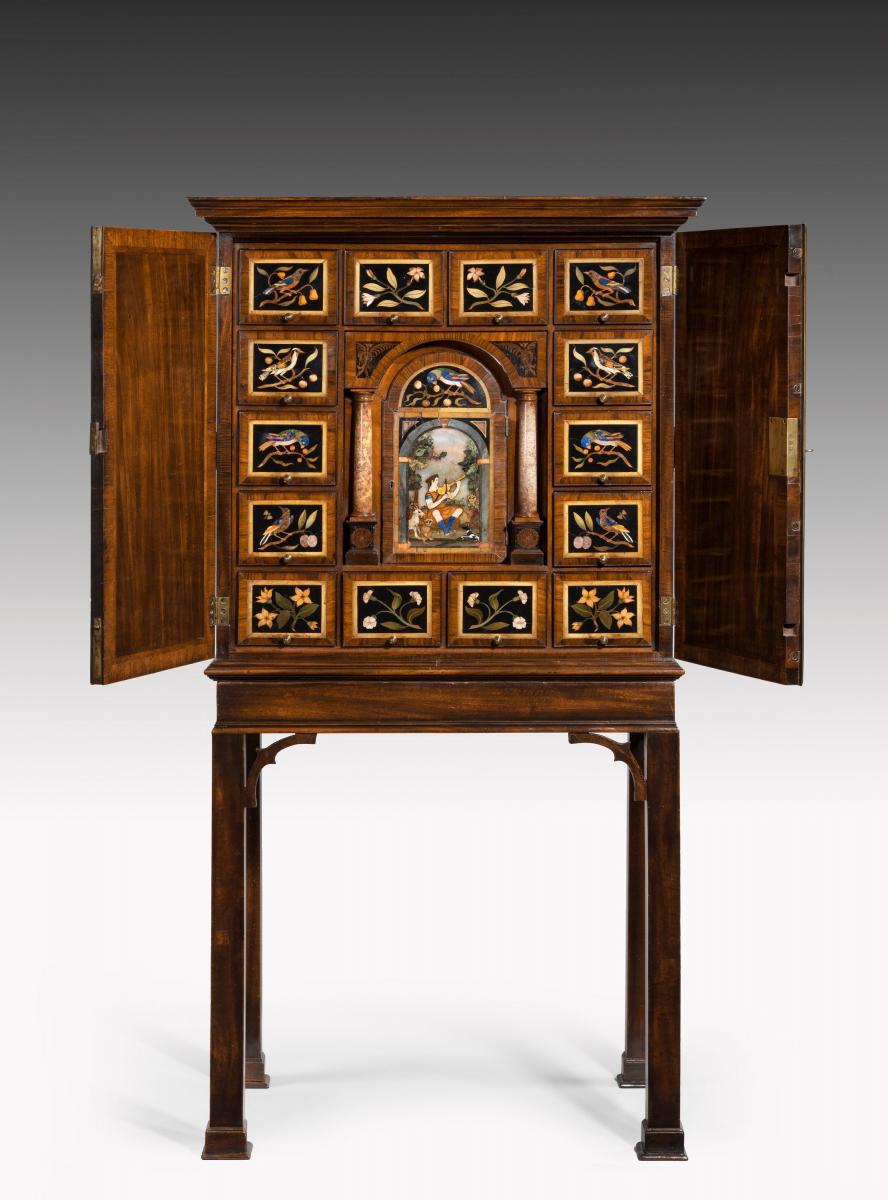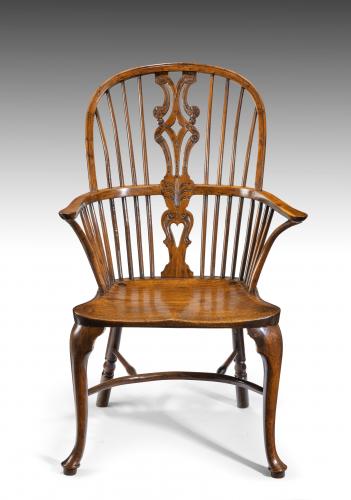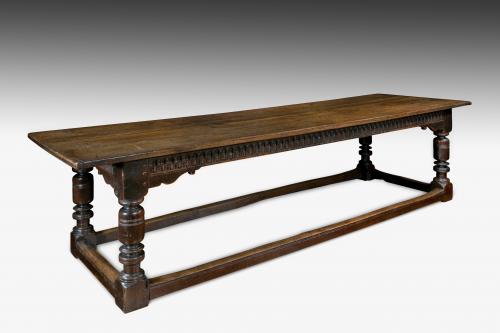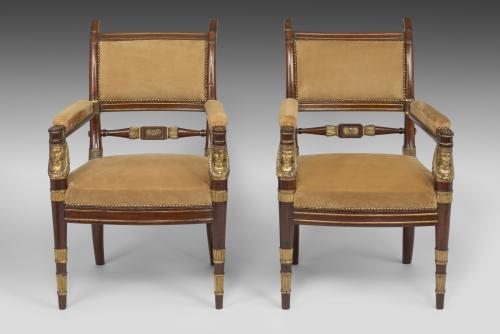

This object is eligible for a Certificate of BADA Provenance
The BADA Standard
- Since 1918, BADA has been the leading association for the antiques and fine art trade
- Members are elected for their knowledge, integrity and quality of stock
- Our clients are protected by BADA’s code of conduct
- Our dealers’ membership is reviewed and renewed annually
- Bada.org is a non-profit site: clients deal directly with members and they pay no hidden fees
Provenance: Acquired by Harry John Hyams (1928-2015) for Ramsbury Manor in the 1960s.
The Pietra Dura Panels – Attributed to the Grand Ducal Workshops – FLORENCE, Second Half of the 17th Century
The Cabinet-On-Stand – ENGLAND, circa 1755
The moulded cornice above a pair of doors, enclosing a fitted interior veneered in padouk and inset with sixteen specimen pietra dura panels. Of the fourteen panels positioned on the drawer fronts six depict flowers and eight depict birds perched on branches bearing fruit. The arched door in the centre of the cabinet depicts Orpheus surrounded by charmed animals, flanked by columns and enclosing a further drawer and an open compartment. This cabinet-on-stand was expressly manufactured to display this collection of 17th Century pietra dura panels, and would have been the focal point of the principal room in which it was placed. The cabinet, with original gilt brass escutcheons and carrying handles, stands on veneered square chamfered legs and pierced brackets.
Florentine Pietra Dura and the Galleria de’ Lavori
In 1588, Grand Duke Ferdinando I of Tuscany founded the Galleria de’ Lavori, the Medici grand-ducal hardstone workshop in Florence. The Grand Duke hired and trained local craftsmen to restore ancient carved-stone objects and to create original works in pietra dura, making pictures by setting together thin pieces of brightly coloured stones. During the 1600s, the Galleria worked primarily in Florence, concentrating on the decorations of the Medici family’s chapel in the church of San Lorenzo, begun in 1605. By the 1700s, pietra dura became increasingly fashionable, and artists trained in this workshop travelled all over Europe to work for other noble or royal households, with elaborate pieces being commissioned by the aristocracy and nobility of Europe, who then commissioned a custom-made piece of furniture to display their stonework. Pictorial pietra dura panels depicting flowers, fruit and birds, set on a background of black marble edged with yellow marble borders, were the favourite compositions for the Galleria de’ Lavori. Renamed the Opificio delle Pietre Dure in the mid-1800s, the workshop continues to operate today as a state-supported institution.
The panels in this cabinet would have been assembled by a wealthy patron whilst he was undertaking the Grand Tour. The cabinet would then have been commissioned in order to display the panels. Such cabinets fulfilled several functions: as a ‘cabinet of curiosities’ in which precious items were kept; as a statement piece of furniture to demonstrate the refined learning of the cabinet’s owner; and to demonstrate the patron’s wealth and prestige.
An example of such a cabinet is the Badminton Cabinet, sold twice at Christie’s, most recently on 9th December 2004. These Florentine ebony cabinets with pietra dura panels demonstrate the technique of hardstone inlay using rare and semi-precious stones, and were among the most expensive items of furniture made during the late 16th and 17th Centuries. Such panels and stones were treasured for the quality of the precious hardstones and figuring and for their association with regions with rich historic and mythological associations. Another such cabinet is illustrated by Anna Maria Massinelli in ‘Hardstones: The Gilbert Collection’ (Philip Wilson Publishers, London, 2000, pp.36-7).
The central panel depicts the legendary poet, Orpheus, who, according to Greek mythology, received a lyre from Apollo and was taught to play the instrument by the Muses. He used his lyre to charm the animals, birds and reptiles, which are shown gathered around him. The scene is based on an etching by Antonio Tempesta (1555–1630) entitled ‘Orpheus Charming the Birds and the Animals’ (Harvard Art Museums/Fogg Museum, object no. S9.26; http://www.harvardartmuseums.org/art/236391) and it became one of the Galleria de’ Lavori’s most popular subjects. There are at least twenty two documented pieces of furniture which reflect the high technical standards of the workshop, each with a slightly varied central Orpheus plaque and different animal panels (Annamaria Giusti and Wolfram Koeppe (Eds.), ‘Art of the Royal Court: Treasures in Pietre Dure from the Palaces of Europe’ (New Haven and London, 2008), pp. 176-177.)).
The ‘Barberini Cabinet’, dated circa 1606-23, which is held in the collection of the Metropolitan Museum of Art, New York, seems to be the earliest object of this important group depicting Orpheus charming the animals. It was made for Cardinal Maffeo Barberini (1568-1644), the son of a Florentine merchant, and later Pope Urban VIII (Wrightsman Fund, 1988, Accession Number 1988.19). This central panel is framed by a tabernacle flanked by Tuscan columns, also found on Florentine 17th Century cabinets.
The documented hardstone plaques which depict Orpheus include an ebony and pietre dure table cabinet, dated circa 1620, formerly in the collection of the Frescobaldi family of Florence, which is now in the collection of the Detroit Institute of Arts (Accession Number-1994.77; https://www.dia.org/art/collection/object/pietre-dure-cabinet-25433).
Another cabinet, dated 1650, and housed at Chirk Castle, Wrexham, was probably acquired by Sir Thomas Myddleton during his Grand Tour in the early 1670s (NT 1170817.1; http://www.nationaltrustcollections.org.uk/object/1170817.1).
It is possible that the smaller panels of flowering branches and birds may derive from Jacopo Ligozzi’s (1547-1627) drawings of birds and flora. He was commissioned to create some of the depictions found in the encyclopaedic visual catalogue of the plant collections of Bolognese Ulisse Aldrovandi which are held in the Gabinetto Disegni e Stampe of the Uffizi Gallery, Florence.
Pietra dura panels of the same design from the second half of the 17th Century panels are featured on an Italian cabinet-on-stand, which was sold at Christie’s, King Street on 10th June 2004, lot 22.
‘The Cucci Cabinet’, designed by 17th Century Italian furniture master Domenico Cucci, and sold at Christie’s ‘500 Years: Decorative Arts Europe’ sale on 10th December 2009, has a central panel depicting Orpheus playing his lyre. The cabinet was almost certainly acquired by Queen Hedvig Eleonora (1636-1715), who was married to King Charles X of Sweden (1622-1660). The cabinet is dated before circa 1665-1670.
The mahogany cabinet-on-stand dates from the 1750s. Thomas Chippendale included a design for a similar cabinet and stand in ‘The Gentleman and Cabinet-Maker’s Director’, plate CXX (‘Thomas Chippendale: The Gentleman and Cabinet-Maker’s Director’ (Dover Publications Inc., New York, 1966) – see image below).
The original carrying handles on our cabinet (see image below) closely resemble, with very minimal variations, a winged handle escutcheon which can be found on a padouk chest of drawers by John Channon, and which is illustrated in ‘Channon Revisited’ (Christopher Gilbert and Tessa Murdoch, ‘Channon Revisited’ in ‘Furniture History’, vol. 30 (1994), p.73, fig. 12 – see image below). Gilbert and Murdoch comment that: ‘[t]he winged, openwork handles are cast from the same moulds as those encountered on the so-called ‘nymph and satyr’ group.’ (ibid, p.75).
Bibliography:
‘Thomas Chippendale: The Gentleman and Cabinet-Maker’s Director’ (Dover Publications Inc., New York, 1966).
Anna Maria Massinelli, ‘Hardstones: The Gilbert Collection’ (Philip Wilson Publishers, London, 2000).
Annamaria Giusti and Wolfram Koeppe (Eds.), ‘Art of the Royal Court: Treasures in Pietre Dure from the Palaces of Europe’ (New Haven and London, 2008).
Dimensions
Width: 81cm; Height: 155.5cm; Depth: 50cmStock number
6479The BADA Standard
- Since 1918, BADA has been the leading association for the antiques and fine art trade
- Members are elected for their knowledge, integrity and quality of stock
- Our clients are protected by BADA’s code of conduct
- Our dealers’ membership is reviewed and renewed annually
- Bada.org is a non-profit site: clients deal directly with members and they pay no hidden fees




